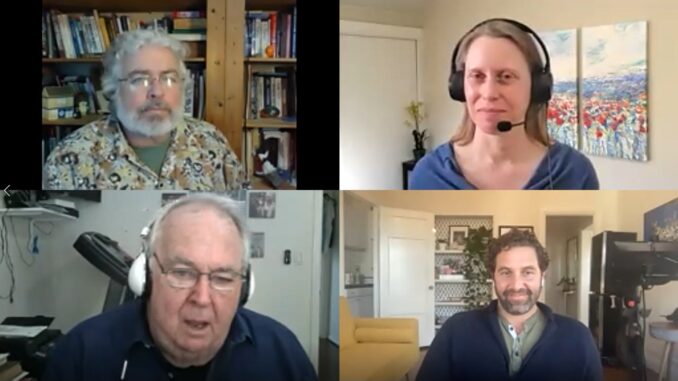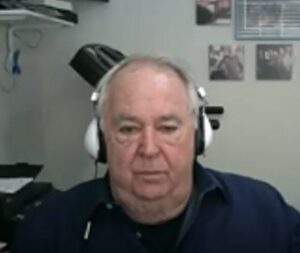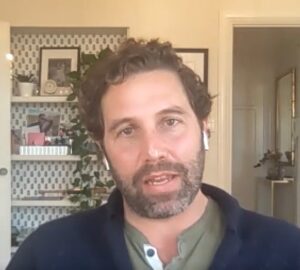
By Fraser Perkins —
The Palos Verdes Democrats met by Zoom on March 21 for a close look at our criminal justice system. The lead presenters were Stephen Downing and Max Szabo. Stephen Downing began his 20-year police career in a squad car and finished as a deputy chief of police; retiring in 1980. During his career he became an expert on issues related to police militarization, civil asset forfeiture, corruption and internal affairs. Max Szabo led several successful reform efforts as Deputy District Attorney under District Attorney George Gascón when he was San Francisco’s DA and consulted on Gascón’s Los Angeles County DA campaign.
 Steve Downing began his presentation by showing how the use of force, militarization and role modeling have shaped policing. He cited an incident early in his career, when he and his partner successfully de-escalated a violent suspect, only to be chastised by the supervising detective. Downing commented, “We were able to take him into custody without harm to either suspect or police officers,” yet the detective felt the officers should have used deadly force. Mr. Downing believes it’s critical to reverse a culture of militarization, provide better role models, and incorporate escalation/de-escalation techniques into police training. “The taking of a human life should only be as a last resort.” This means every reasonable measure — talking, tactics, and de-escalation — should be used before a life is taken.
Steve Downing began his presentation by showing how the use of force, militarization and role modeling have shaped policing. He cited an incident early in his career, when he and his partner successfully de-escalated a violent suspect, only to be chastised by the supervising detective. Downing commented, “We were able to take him into custody without harm to either suspect or police officers,” yet the detective felt the officers should have used deadly force. Mr. Downing believes it’s critical to reverse a culture of militarization, provide better role models, and incorporate escalation/de-escalation techniques into police training. “The taking of a human life should only be as a last resort.” This means every reasonable measure — talking, tactics, and de-escalation — should be used before a life is taken.
Downing highlighted key moments in the history of criminal justice. In the 1989 Graham v Connor decision, the Supreme Court held that use of force claims must be evaluated under objective and reasonable standards. Downing believes this decision led to an increase in what he calls, “waistband shootings,” where a police officer discharges his weapon as soon as a suspect reaches for his waistband. Downing cited “junk science” as another factor in police shootings. Following passage of CA AB 382 in 2019, which stipulated the taking of a life as a last resort, Long Beach police shootings went from an average of six per year down to zero over an eighteen month period.
Downing examined how SWAT (Special Weapons and Tactics) teams have evolved. The Los Angeles Police Department (LAPD) originated the SWAT team. The police department not only had stringent roll-out requirements for SWAT teams, but spent 50% of their time training in SWAT tactics. The results were startling — over 95% of their rollouts ended with neither injury nor death to either suspect or police officer. SWAT teams became popular with even small departments applying for funding of large ticket items and weaponry. To counteract inappropriate use of SWAT teams, Downing believes there should be regional SWAT teams for small departments and uniform training.
Police unions present another challenge. As a command officer, Downing could investigate complaints and respond to local communities, especially in cases involving use of force, bad language or racial slurs. A key component of success was the formation of a police-clergy council. Starting in 1978, police unions advocated for, and obtained approval at the state level, of a police bill of rights. While some components such as due process were appropriate, Downing says, “It shut down the ability for a commanding officer or chief of police to explain how he dealt with community complaints.” Without transparency, the police bill of rights also led to hiding of police misconduct. Recently passed CA SB 1421 provided for police transparency, especially in complaints involving use of force, police shootings and sexual misconduct. Downing would like to see this legislation strengthened.
 Max Szabo, spokesperson for George Gascón, began by reviewing enhancements. “Enhancements are additional time that can be added on to that base term.” Many crimes, such as robbery, come with a variety of enhancements, which can lengthen the term. In Szabo’s view, enhancements are the driving force behind mass incarceration throughout the country. What’s more, enhancements don’t promote safety and exacerbate recidivism. A second problem with enhancements, according to Szabo, is “they are littered with racial disparities.”
Max Szabo, spokesperson for George Gascón, began by reviewing enhancements. “Enhancements are additional time that can be added on to that base term.” Many crimes, such as robbery, come with a variety of enhancements, which can lengthen the term. In Szabo’s view, enhancements are the driving force behind mass incarceration throughout the country. What’s more, enhancements don’t promote safety and exacerbate recidivism. A second problem with enhancements, according to Szabo, is “they are littered with racial disparities.”
Szabo noted that California led the tough on crime era, which caused a corresponding increase in our prison population:
1980 – 20,000 in prison
1990 – 90,000 in prison
1994 – 3 strikes passed
1999 – 160,000 in prison
High visibility cases have also had a major impact on criminal justice. The Charles Manson case led to reinstatement of the death penalty and life imprisonment without parole. The Polly Klass case led to three strikes legislation.
Szabo reviewed several of DA George Gascón directives:
Enhancements – “Mr. Gascón got rid of enhancements in total.” After discussions with the community, he modified his position by allowing enhancements only in those cases involving the most vulnerable victims. Szabo noted that parole boards are adept at assessing recidivism. They grant paroles in 15 – 30% of cases and see a recidivism rate of about half of 1%. “Prosecutors are not very good at assessing future human risk.” There has been a lot of unwarranted fear about release of prisoners currently serving life terms without parole.
Death Penalty – Szabo noted that Mr. Gascón, “took the death penalty off the table.” Szabo said the death penalty is not a deterrent and is racially based. Since 1978, there have been 13 executions in California – the last one was in 2006. The death penalty is an expensive/ineffective policy.
Bail – Szabo reported that Mr. Gascón, “took bail off the table for low level, nonviolent offenses.” The ultimate goal is to replace bail with pretrial detention (holding a suspect from time of custody to rendering of a verdict). The current bail system discriminates against the poor and allows the rich to simply post bail. Szabo noted, “Money is not a proxy for risk.” Pretrial detention will be reserved for suspects that pose a danger to society, without regard to the financial resources of a suspect.
Teens – Szabo noted, “They [teens] do dumb things.” As a result, it is questionable to hold teens to the same standards as adults. On release, teens incarcerated for several years wind up with a higher recidivism rate than if they had been treated as juveniles. The fundamental question is whether the criminal justice system for juveniles should be rehabilitative, or focus on retribution.
Survivors of Crime – Szabo atated, “The Criminal Justice System does a bad job of actually supporting survivors of crime.” And, he added, “Hurt people hurt people.” Once crime is normalized for a victim, the victim themselves may turn to crime. One major goal for Mr. Gascón is to support crime victims. In San Francisco, Mr. Gascón used three tactics to bolster survivor support — more support, quick intervention, and moving support to the community, rather than providing support in a more remote location such as a police station.
Re-sentencing Initiative – Szabo stated that Mr. Gascón believes, “The pursuit of justice is timeless,” and there will be an initiative to examine current sentencing terms. He noted that 95% of prisoners who have been incarcerated for 20+ years pose little risk to reoffend, and 50% of all prisoners pose little risk of recidivism. The cost of housing one prisoner is $81,000/year. Szabo concluded by saying, from the viewpoint of both justice and finances, a review of sentencing is warranted.
During the Q&A session, Tony Hale asked Szabo, “What was the thinking that removing all enhancements was the right way to go?” Szabo responded: The current sentencing spread provides serious terms without enhancements; there are insufficient resources to examine the nuances of every case; a 25-to-life sentence for murder doesn’t need a 60-year term; and, enhancements drive mass incarceration and don’t provide safety.
Tony followed up, “The point of where the controversy came from was that we couldn’t prosecute hate crimes.” Szabo responded by noting that a hate crime associated with an assault could be prosecuted as an assault, as well as a hate crime. Hate crimes committed without an assault was one of the factors which led Mr. Gascón to reconsider his initial position. Even without enhancements, the use of a gun during a crime would provide several charges, which with conviction, would result in a lengthy prison term. Szabo also cautioned that felony conviction for minor crimes impairs the ability of a felon to get a job after their term is finished and may contribute to our homelessness problem.
Following up on enhancements and a question about police unions, Downing agreed with Szabo about the effects of enhancements and incarcerations. He continued by noting, “I think the police union problem is a national problem.” Through campaign contributions, the police unions have tremendous power not only in Long Beach, but in many other California jurisdictions as well. The undue influence of the police union in financial and disciplinary actions must be balanced against the due process concerns of the police. Downing cited Long Beach as an example of a police union circumventing SB 1421, by convincing the LB City Council to pass a statue that provides five days of advance warning before the public can view any documented disciplinary actions against a police officer.
Szabo commented that many reform efforts may actually benefit police officers. In some jurisdictions, up to 80% of calls involve someone with a mental health crisis, which police are not trained to handle. He also noted that if funds are diverted away from police to other professionals, the financial power of police unions would be impacted.
When asked about rehabilitation, restorative justice and survivor support, Szabo cited 2014 as a watershed year. Before 2014, the felony threshold for robbery was $400. After Proposition 47 passed in 2014, raising the threshold for robberies to $950, reforms, property crime, recidivism and racial disparity all decreased. He continued by noting that the majority – not all – but, a majority of victims favor rehabilitation after their initial shock has subsided. Victim-offender mediation is a powerful tool for both victim and offender as they journey toward recovery. Youthful offenders respond particularly well to mediation, leading to lower rates of recidivism. Szabo noted that the metrics of success for Deputy DAs depend on convictions and years of incarceration. A better barometer would be which outcome is best for the victim, the community and the offender. Deputy DAs are also afraid of consequences should they request a sub maximum sentence for an offender, who then gets out and commits a subsequent crime.
 To further the discussion on police accountability, moderator Ann Nye, spoke about SB 2, which Senator Bradford and Senator Toni Atkins (San Diego) introduced in Dec 2020. This bill will hold law enforcement officers that commit serious misconduct and illegally violate a person’s civil rights accountable by creating a statewide decertification process. In addition, Natasha Minske, representative for Senator Ben Allen, educated us about SB 483, which Allen introduced in Feb 2021. This bill is based on the recommendations by the California Committee on Revision of the Penal Code to repeal two sentencing enhancements that were unfair and applied in a racially biased manner, but the date for removal was not retroactive. These enhancements, sometimes called “zombie” enhancements, are dead, but not for those already serving time. Minske said, SB 483 corrects this injustice and removes these enhancements retroactively from sentences already being served. Natasha explained the two enhancements SB 483 seeks to amend are: 1) If a suspect is convicted of a second drug-related crime, three years are added, and 2) A convicted felon with a history of time in either jail or prison receives an additional year of incarceration.
To further the discussion on police accountability, moderator Ann Nye, spoke about SB 2, which Senator Bradford and Senator Toni Atkins (San Diego) introduced in Dec 2020. This bill will hold law enforcement officers that commit serious misconduct and illegally violate a person’s civil rights accountable by creating a statewide decertification process. In addition, Natasha Minske, representative for Senator Ben Allen, educated us about SB 483, which Allen introduced in Feb 2021. This bill is based on the recommendations by the California Committee on Revision of the Penal Code to repeal two sentencing enhancements that were unfair and applied in a racially biased manner, but the date for removal was not retroactive. These enhancements, sometimes called “zombie” enhancements, are dead, but not for those already serving time. Minske said, SB 483 corrects this injustice and removes these enhancements retroactively from sentences already being served. Natasha explained the two enhancements SB 483 seeks to amend are: 1) If a suspect is convicted of a second drug-related crime, three years are added, and 2) A convicted felon with a history of time in either jail or prison receives an additional year of incarceration.
Downing added that the list of progressive DAs is growing, resulting in more professionalism within police departments. He believes the relationship between police and the DA is a cooperative effort in a checks and balances environment, rather than a partnership. He summed up the goal of the justice system as seeking justice, rather than simply getting a conviction.
In terms of the recall effort against Mr. Gascón, Szabo thinks the recall effort will be expensive and difficult. Republicans lead all recall campaigns. Downing added that the police unions have been active in some of the recalls.
In his closing remarks, Downing commented, “As to the change in the [police] culture, that’s probably the toughest thing to do and it’s always long term.” A major factor in changing the culture of the LAPD was the consent decree. [A consent decree is an agreement or settlement that resolves a dispute between two parties without admission of guilt.] He cited several other factors which have changed the culture of the LAPD: a code of ethics, outside advisors, and revamping of training and recruitment. In his view, smaller departments such as Long Beach lag behind and desperately need the same changes.
Szabo concluded, “There was really no data or science that ever supported the creation of the policies of mass incarceration.” Looking forward, he expects future policies to be data and science driven.
Afterwards, PV Dems member Steve Goldsmith provided us information about a terrific youth restorative justice program using trained volunteers to mediate between offenders and victims. The website is cys-la.org and the phone number is 213-986-7604. Based in Hawthorne, it serves all of LA County.
To see the video of our meeting, please click below:

Leave a Reply